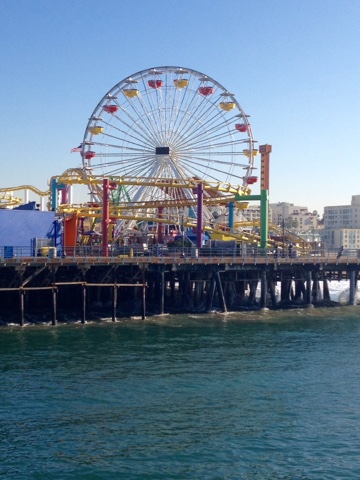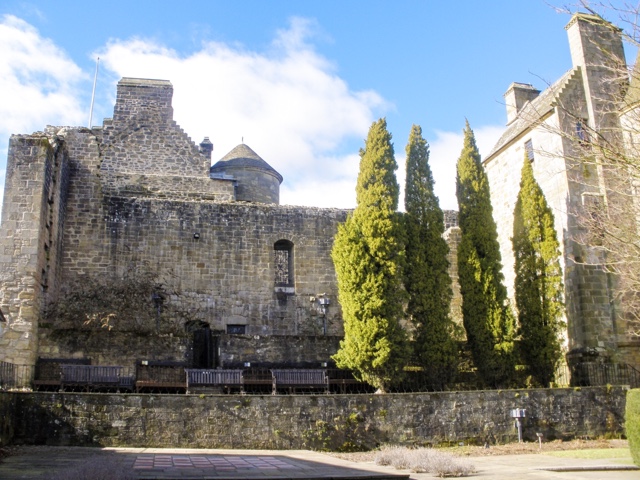The current Santa Monica Pier consists of two adjoining piers. The first pier is a 1600-foot-long Municipal Pier that was opened in 1909 to carry sewer pipes beyond the breakers. In order to combat the weather and sea conditions, the pier was the first one on the west coast to be constructed of concrete. In 1916, Charles I. D. Looff and his son, Arthur, constructed a short wide adjoining pier to the Municipal Pier. Looff was a Danish-born American master carver and builder of carousels. During his life he built 40 carousels, rollercoasters, Ferris wheels and several amusements parks. The Pleasure Pier, built in Santa Monica by Looff and his son, included the Looff Hippodrome building which, by 1922, would house the beautifully carved 40-horse carousel, a wooden rollercoaster, the Whip, merry-go-round, a Wurlitzer Organ and a Funhouse. The Looff carousel was so popular he added another row of horses.
In 1919, the concrete piles unexpectedly collapsed. This resulted in a two-year process of replacing the concrete piles with creole-treated wooden piles. Eventually, the concrete deck was also replaced by treated wooden deck boards.
After years of thriving, the popularity of the pier waned during the depression years. Following the death of his father, in 1924, Arthur Looff sold the Pleasure Pier to the Santa Monica Amusement Company. They decided to build the biggest ballroom in the world. They hired T.H. Eslick to design the building with a Spanish facade and a French Renaissance interior. The La Monica Ballroom opened on July 23rd, 1924. More than 50,000 people attended the opening. Equipped with a 15,000-square-foot hard maple floor, the Ballroom served many purposes in its time, including a venue for a radio show, a car exhibition and even a rollerskating rink. Sadly, the La Monica Ballroom was demolished in 1963.
During the 1930s, the pier was primarily used as a ferry dock. In 1938, the pier gate and bridge were constructed. The amusement park facilities were closed down and some of the attractions were sold. In 1943, Walter Newcomb, a Venice banker, purchased the pier from the Santa Monica Amusement Company and changed its name to Newcomb Pier. He revitalised the amusement park and replaced the ageing Looff carousel with a 1922 Philadelphia Toboggan Carousel. Following Walter's death in 1948, his wife, Enid, took over the management of the pier for the next 26 years.
In the 1950s, George and Eugene Gordon purchased the pier. The pier started to fall into disrepair and, in the 1960s, many of the buildings - including the Hippodrome - were used as apartments. These apartments attracted all manner of bohemians, artist, actors and hippies. In 1975, the apartments were destroyed by fire. Becoming more and more of an eyesore, the city acquired the pier and various plans were discussed to remove the pier. In response to these proposals, the citizens of Santa Monica created a group called "Save Santa Monica Pier". It was decided that the pier should be preserved.
In January 1983, a huge storm hit Santa Monica, destroying the lower deck of the pier. In March, when the repairs had just started, another storm hit. This second storm dragged a crane that was repairing the pier into the sea. As it was dragged into the sea, the crane battered at the pier. A third of the pier was destroyed.
In 1987, work was started to rejuvenate the pier. Concrete pilings and a concrete fishing deck were added. Santa Monica Pier now has restaurants, bars, shops, entertainment arcades and an amusement park.
The Santa Monica Pier is said to be haunted by a tall shadowy figure. This figure has been seen walking across the roofs of various of the pier buildings, as well as riding on the carousel. As far back as the 1960s, people living in the apartments in buildings on the pier reportedly heard the carousel organ playing in the middle of the night, despite no-one having access to the carousel.
The Santa Monica Pier is a popular fishing spot and, over the years, several fishermen have disappeared from the pier, leaving fishing buckets and rods behind. Some believe that they were mugged or swept out to sea. Many people have reported hearing the sound of dull footsteps, spinning reels and rattling fishing buckets at the end of the pier when no-one has been on site.
I have been to Santa Monica Pier many times, and always enjoy my visits to this beautiful place on the sea.

























































